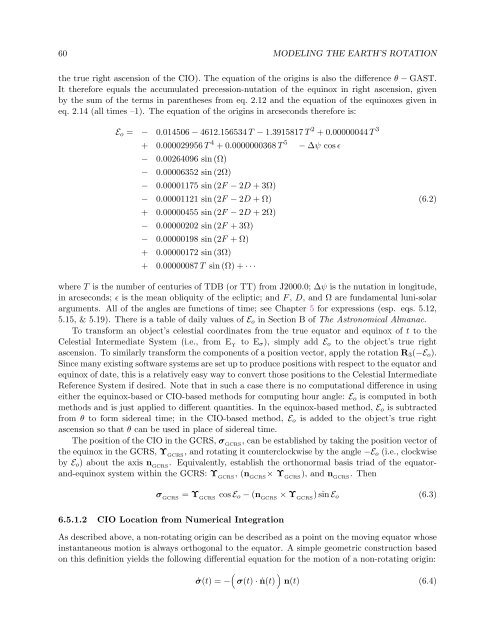USNO Circular 179 - U.S. Naval Observatory
USNO Circular 179 - U.S. Naval Observatory
USNO Circular 179 - U.S. Naval Observatory
Create successful ePaper yourself
Turn your PDF publications into a flip-book with our unique Google optimized e-Paper software.
60 MODELING THE EARTH’S ROTATION<br />
the true right ascension of the CIO). The equation of the origins is also the difference θ − GAST.<br />
It therefore equals the accumulated precession-nutation of the equinox in right ascension, given<br />
by the sum of the terms in parentheses from eq. 2.12 and the equation of the equinoxes given in<br />
eq. 2.14 (all times –1). The equation of the origins in arcseconds therefore is:<br />
Eo = − 0.014506 − 4612.156534 T − 1.3915817 T 2 + 0.00000044 T 3<br />
+ 0.000029956 T 4 + 0.0000000368 T 5 − ∆ψ cos ɛ<br />
− 0.00264096 sin (Ω)<br />
− 0.00006352 sin (2Ω)<br />
− 0.00001175 sin (2F − 2D + 3Ω)<br />
− 0.00001121 sin (2F − 2D + Ω) (6.2)<br />
+ 0.00000455 sin (2F − 2D + 2Ω)<br />
− 0.00000202 sin (2F + 3Ω)<br />
− 0.00000198 sin (2F + Ω)<br />
+ 0.00000172 sin (3Ω)<br />
+ 0.00000087 T sin (Ω) + · · ·<br />
where T is the number of centuries of TDB (or TT) from J2000.0; ∆ψ is the nutation in longitude,<br />
in arcseconds; ɛ is the mean obliquity of the ecliptic; and F , D, and Ω are fundamental luni-solar<br />
arguments. All of the angles are functions of time; see Chapter 5 for expressions (esp. eqs. 5.12,<br />
5.15, & 5.19). There is a table of daily values of Eo in Section B of The Astronomical Almanac.<br />
To transform an object’s celestial coordinates from the true equator and equinox of t to the<br />
Celestial Intermediate System (i.e., from E Υ to Eσ), simply add Eo to the object’s true right<br />
ascension. To similarly transform the components of a position vector, apply the rotation R3(−Eo).<br />
Since many existing software systems are set up to produce positions with respect to the equator and<br />
equinox of date, this is a relatively easy way to convert those positions to the Celestial Intermediate<br />
Reference System if desired. Note that in such a case there is no computational difference in using<br />
either the equinox-based or CIO-based methods for computing hour angle: Eo is computed in both<br />
methods and is just applied to different quantities. In the equinox-based method, Eo is subtracted<br />
from θ to form sidereal time; in the CIO-based method, Eo is added to the object’s true right<br />
ascension so that θ can be used in place of sidereal time.<br />
The position of the CIO in the GCRS, σ GCRS , can be established by taking the position vector of<br />
the equinox in the GCRS, Υ GCRS , and rotating it counterclockwise by the angle −Eo (i.e., clockwise<br />
by Eo) about the axis n GCRS . Equivalently, establish the orthonormal basis triad of the equatorand-equinox<br />
system within the GCRS: Υ GCRS , (n GCRS × Υ GCRS ), and n GCRS . Then<br />
σ GCRS = Υ GCRS cos Eo − (n GCRS × Υ GCRS ) sin Eo (6.3)<br />
6.5.1.2 CIO Location from Numerical Integration<br />
As described above, a non-rotating origin can be described as a point on the moving equator whose<br />
instantaneous motion is always orthogonal to the equator. A simple geometric construction based<br />
on this definition yields the following differential equation for the motion of a non-rotating origin:<br />
<br />
<br />
˙σ(t) = − σ(t) · ˙n(t) n(t) (6.4)


